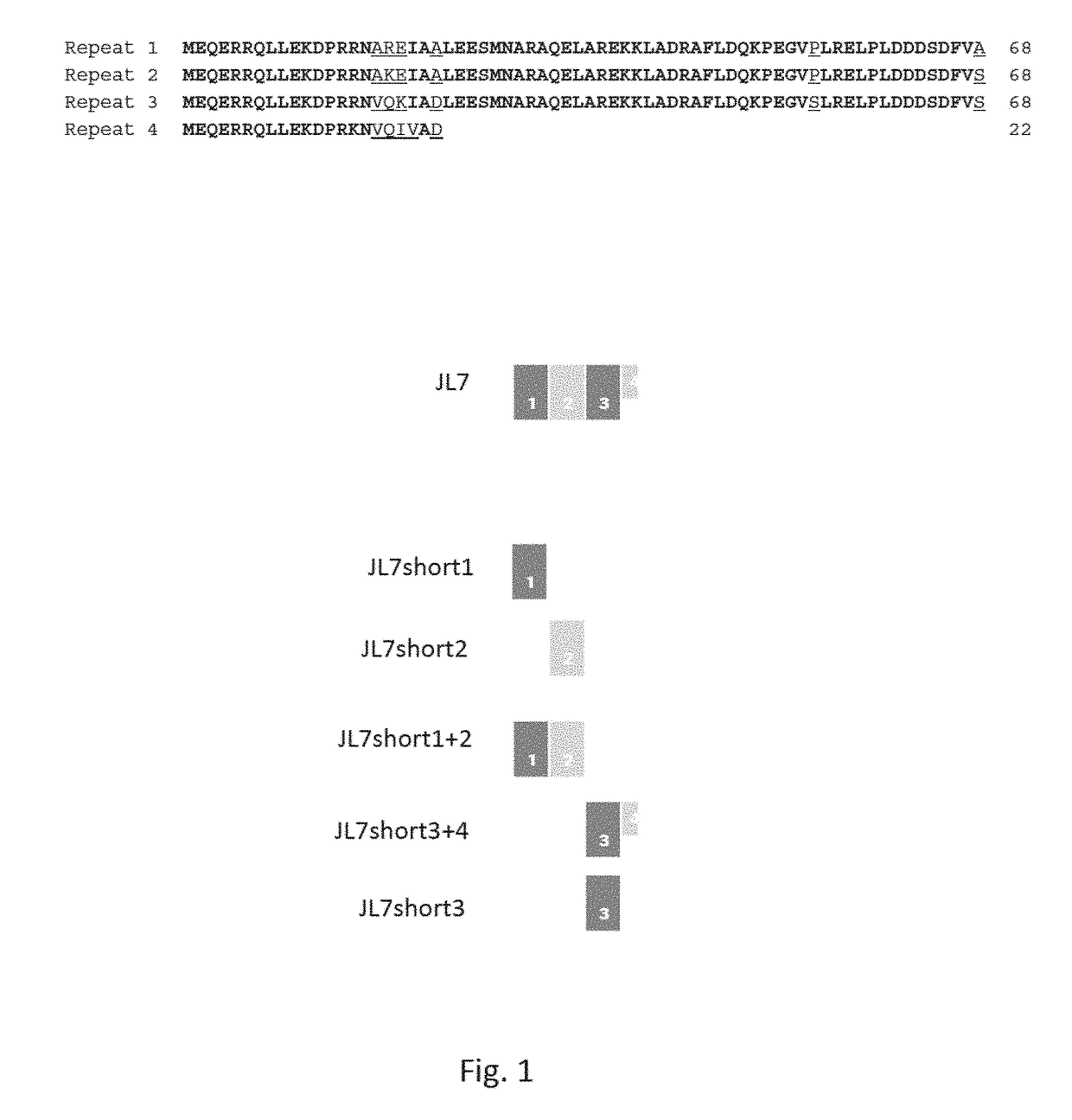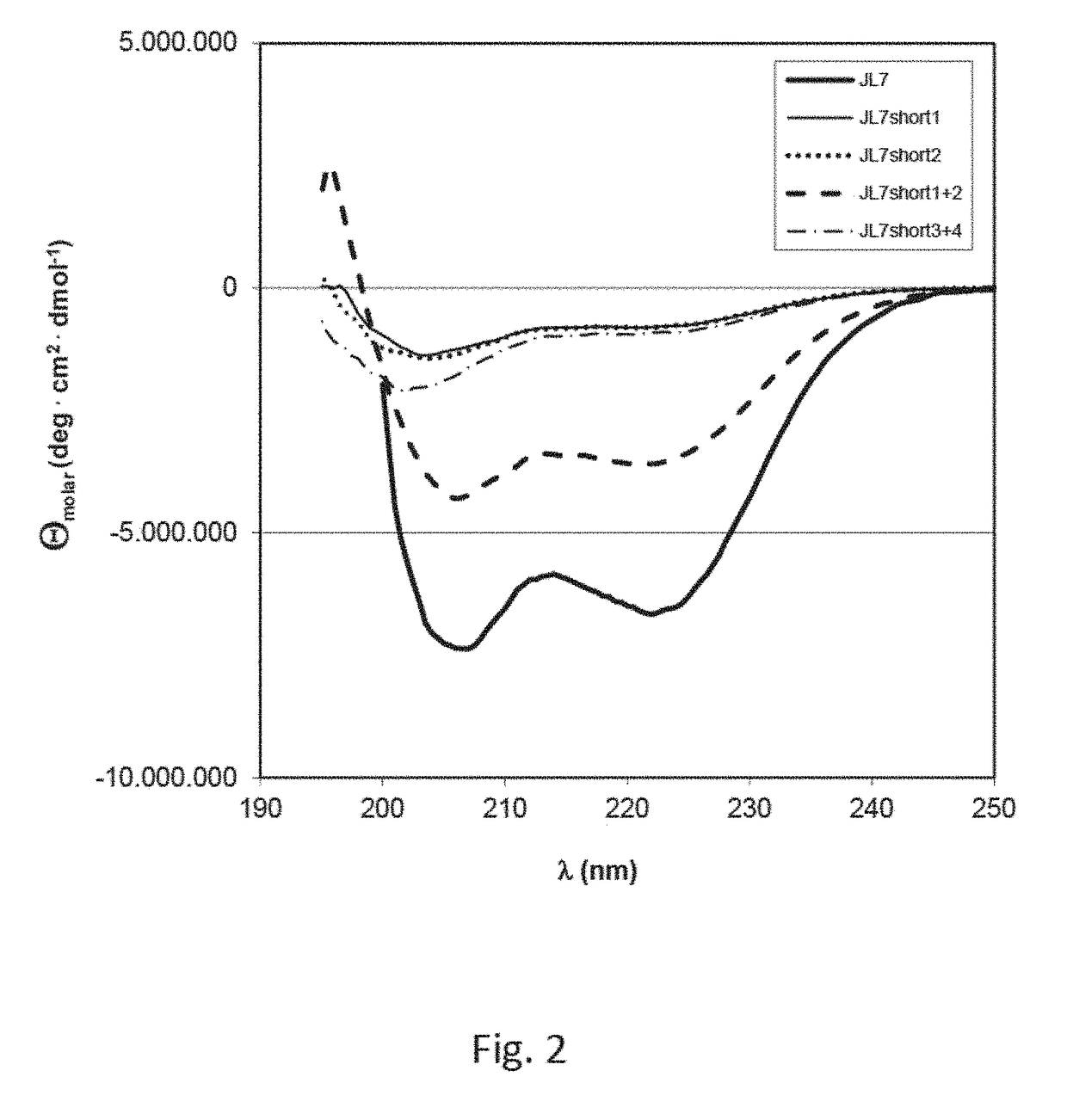Recombinant trypanosoma cruzi jl7 antigen variants and their use for detecting chagas disease
- Summary
- Abstract
- Description
- Claims
- Application Information
AI Technical Summary
Benefits of technology
Problems solved by technology
Method used
Image
Examples
example 1
Cloning and Purification of the Trypanosoma cruzi JL7 Antigen Variants
[0057]In order to investigate the minimal size of the T. cruzi JL7 antigen suitable for its application in an immunodiagnostic test several variants consisting of one or two repeat units were generated.
[0058]Synthetic genes encoding the T. cruzi antigens as listed in table 1 were purchased from Eurofins MWG Operon (Ebersberg, Germany). On the basis of the pET24a expression plasmid of Novagen (Madison, Wis., USA) the following cloning steps were performed. The vector was digested with Ndel and Xhol and a cassette comprising the respective T. cruzi antigens were inserted. The insert of the resulting plasmid was sequenced and found to encode the desired protein. The amino acid sequences of the resulting proteins are shown in the sequence protocol of the present invention. All recombinant T. cruzi polypeptide variants contained a C-terminal hexahistidine tag (SEQ ID NO. 7) to facilitate Ni-NTA-assisted purification. S...
example 2
Spectroscopic Measurements
[0061]Circular dichroism spectroscopy (CD) is the method of choice to assess the secondary structure in proteins. Ellipticity in the amide region (190-250 nm) reflects regular repetitive elements in the protein backbone, i.e. the secondary structure.
[0062]Near-UV CD spectra were recorded with a Jasco-720 spectropolarimeter with a thermostatted cell holder and converted to molar ellipticity. The buffer was 10 mM potassium phosphate pH 7.5. The pathlength was 0.1 cm, the protein concentration was 0.2 mg / ml. The band width was 1 nm, the scanning speed was 50 nm / min at a resolution of 1 nm and the response was 2 s. In order to improve the signal-to-noise ratio, spectra were measured eight timesand averaged.
[0063]FIG. 2 shows far-UV CD spectra of JL7, JL7short1, JL7short2, JL7short1+2 and JL7short3+4. The spectra of JL7 and JL7short1+2 point to proteins with high content of α-helical structural elements (signal bands at 208 nm and 222 nm). The spectra of JL7shor...
example 3
Coupling of Biotin and Ruthenium Moieties to T. cruzi JL7 Antigen Variants
[0065]The lysine ε-amino groups of the recombinant proteins were modified at protein concentrations of ˜10 mg / ml with N-hydroxy-succinimide activated biotin and ruthenium labels, respectively. The label / protein molar ratio was adjusted to 5:1 and 15:1 for the biotin and ruthenium label conjugation, respectively. The reaction buffer was 50 mM potassium phosphate (pH 8.5), 150 mM KC1, 0.5 mM EDTA. The reaction was carried out at room temperature for 30 minutes and stopped by adding buffered L-lysine to a final concentration of 10 mM. After the coupling reaction, unreacted free label was removed by passing the crude protein conjugate over a gel filtration column (Superdex 200 HI Load).
PUM
| Property | Measurement | Unit |
|---|---|---|
| Fraction | aaaaa | aaaaa |
| Concentration | aaaaa | aaaaa |
Abstract
Description
Claims
Application Information
 Login to View More
Login to View More - R&D
- Intellectual Property
- Life Sciences
- Materials
- Tech Scout
- Unparalleled Data Quality
- Higher Quality Content
- 60% Fewer Hallucinations
Browse by: Latest US Patents, China's latest patents, Technical Efficacy Thesaurus, Application Domain, Technology Topic, Popular Technical Reports.
© 2025 PatSnap. All rights reserved.Legal|Privacy policy|Modern Slavery Act Transparency Statement|Sitemap|About US| Contact US: help@patsnap.com


